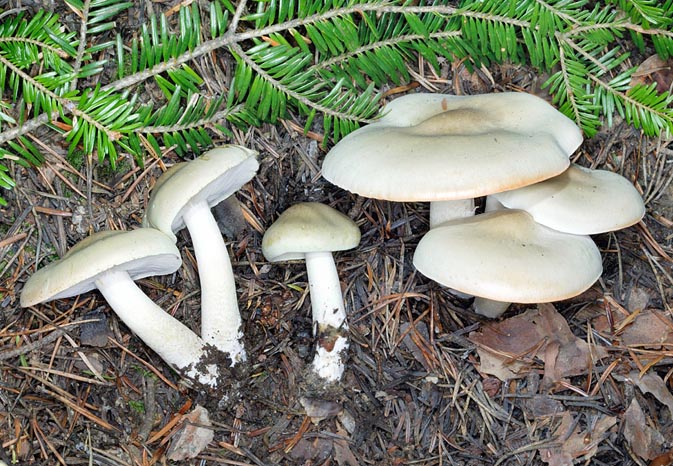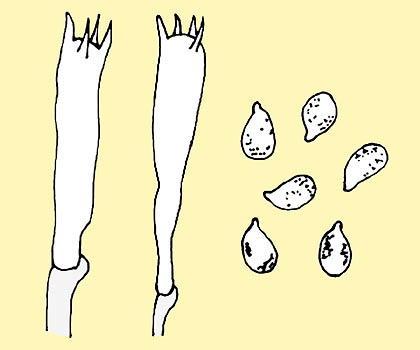
Text © Pierluigi Angeli

English translation by Mario Beltramini

Tricholoma saponaceum is inedible due to its sour Marseille soap taste © Giuseppe Mazza
Family: Tricholomataceae R. Heim ex Pouzar, 1983.
Genus: Tricholoma (Fries) Staude, 1857.
Section: Rigida (Fries) emend. M. Bon.
Tricholoma saponaceum (Fr. : Fr.) Kumm, 1871.
The name of the species comes from the Latin “saponáceus” = concerning the soap.
It is a species which fructifies from the Mediterranean zones up to the Alpine ones, adapting perfectly to whatever type of wood, be it of deciduous or conifer trees, regardless the substratum.
It fructifies from advanced summer to autumn.
In Italy it does not seem to have any dialectal names; in France it is known as “Tricholome à odeur de savon”; for Spain: in Castilian,“Tricoloma de olor a jabón”; in Catalan “tricoloma d’olor de sabó”; in Euskara “Ziza xaboisain”. In Germany, it is known as “Seifen-Ritterling”, in UK, as “soap-scented toadstool”, “soapy knight” or “soap tricholoma”.
For the description of the genus, please refer to Tricholoma columbetta.
Description of the Section
To the section Rigida are ascribed carpophores with cuticle before white-olivaceous then grey-greenish, smooth, more or less glabrous, dry, at times just oily, with darker innate fibrils. Flesh with scent evoking the Marseille soap, bitter taste. Joint buckles mainly present in the hyphae of the hymenophore; pileipellis formed by more or less intertwined hyphae with just prominent terminals, weak pigment.
Description of the species

Tricholoma saponaceum basidia and spores © Pierluigi Angeli
Cap: 3-10 cm, initially hemispheric, then flattened-convex and finally flattened, with little pronounced obtuse umbo, absent at times; margin initially inrolled then rounded and finally almost outstretched, lobed, seldom grooved. Partially detachable cuticle, smooth, glabrous, slimy in the young, then dry, with darker radial fibrils, at times cracked or slightly wrinkled, the colour is variable, greenish grey, grey-pale brown, yellow-greenish, white-ochraceous.
Hymenium: spaced gills trimmed on the margin, decurrent for a short space, wide, initially elastic, intercalated by lamellulas; white before, then cream-olivaceous; entire irregular thread.
Stipe: 5-10 × 1-2 cm, slender, cylindrical, tapered downwards, almost radicant, swollen at times, full then fistulose, fibrous, white under the gills, whitish with brown-greenish, grey-greenish fibres, the base tends to become brown-ochraceous.
Flesh: thick, firm, compact, finally fibrous, off-white, tends to redden when cut especially towards the base of the stipe. The smell is the typical one of the Marseille soap, slightly bitter taste, not mealy.
Habitat: it grows by late summer and in autumn, even late, in groups, numerous at times, ubiquitous, from the plains up to the mountains. Edibility: not edible, even if not toxic, to reject due to the taste and the scent.
Microscopy. Spores: ellipsoidal, smooth, partially guttulate, with prominent apiiculus, 5-6 × 3,5-4,5 µm. Q = 1,47. Basidia: clavate, cylindrical, tetrasporic, with joint buckles, 25-29 × 5-6 µm.
Remarks. This species has numerous varieties and forms, but it can be easily recognized by observing the tints of the cap, which do always have a mix of green and of cream white, or of green and grey. The varieties and the forms are: var. atrivirens (Pers.) Karst., which has smooth stipe and dark green cap; its form saccharriosmum Bon, which has a paler green colour and smells of disinfectant; var. napipes (Krbh.) Bon, which has grey-yellowish cap and yellow gills; var. sulfurinum (Quél.) Rea, which has bright yellow cap and yellowish gills and stipe; its form carneifolium Bert., which has white cap and pink gills; the form nympharum Mal., which has white cap and gills; the var. squamosum (Cke.) Rea, having sooty brown cap, at times even scaly and scaly stipe; its form ardosiacum (Bres.) Bon, which has a very dark colouration, almost blackish with bluish hues, and the stipe with sooty brown scales.
Synonyms: Agaricus saponaceus Fr. 1818 (basionym); Gyrophila saponacea Quél. 1886.
→ For general notions about Fungi please click here.
→ To appreciate the biodiversity of MUSHROOMS please click here.
